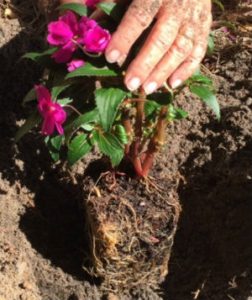Gardeners can greatly enhance the health of their new plants by following recommendations on how to successfully install them. The following guidelines for installing trees and shrubs apply for sandy, well-drained soils, much like we find in Polk County. Listed below are tips for successful planting, and why they are important:
* Dig hole slightly less deep than the height of the root ball. The height of the root ball in the planting hole should be slightly higher than surrounding soil. (This allows for settling). (See “Planting and Establishing Trees”, https://edis.ifas.ufl.edu/pdffiles/EP/ep31400.pdf for further information on planting trees)
* Dig hole 1 ½ – 2 times wider than root ball. (The loosened soil on all sides of the root ball will encourage lateral root development.)
* Keep the bottom of hole flat, leaving soil at the bottom of the hole undisturbed as much as possible. (This helps prevent settling of the plant.)
* Shave off an outer inch or so of the sides and bottom of root ball with knife or sharp shovel. Any remaining circling roots should be pulled away from the root ball prior to planting. (This enhances lateral root development.)
* Make sure root ball is well watered – never plant a dry root ball.
* Do not add amendment to soil in hole unless the surrounding soil is of extremely poor quality. This can create too rich of an environment, discouraging roots from extending into native soil. (Native soil is defined as soil that already exists at planting site.) If amendments are desired, it is best to apply to the entire bed.
* Place tree or shrub in hole; examine from all sides to make sure plant is vertical. Backfill with native soil, gently tamping backfill soil in. You can use a shovel blade or stick to help settle backfill into space to avoid air pockets.
* Do not add soil to the top of the root ball. Do not ever stomp on or compact root ball. (Compacting soil reduces oxygen necessary for root growth.)
* Rake surrounding soil level and smooth for good drainage.
* If desired, add a 3 inch high ring of soil. This should be removed at the end of the first growing season. (Removing this ring will keep roots from developing into this area).
* Water in new plant well, making sure adequate water is applied during the plant’s establishment. This is determined by plant species, size of plant, and season of the year.
* Add mulch to 3 inch depth in the area surrounding the plant; no mulch or very thin on top of root ball.
*Fertilizer – can add slow-release type on top of mulch; there is no need to mix into the planting hole, as most roots end up close to the soil surface in urban landscapes.
Molly Griner has been a UF/IFAS Extension Polk County Master Gardener since 2003.
For more information, contact UF/IFAS Extension Polk County at (863) 519-1041 or visit us online at http://sfyl.ifas.ufl.edu/polk. The Plant Clinic is open Monday-Friday, 9:00 am-4:00 pm to answer your gardening and landscaping questions. Visit us in person, give us a call, or email us at polkmg@ifas.ufl.edu.
 0
0
